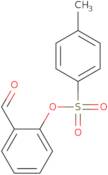2-Formylphenyl 4-methylbenzenesulfonate
CAS: 19820-56-5
Ref. 3D-FF117181
| 1g | Discontinued | ||
| 2g | Discontinued | ||
| 5g | Discontinued | ||
| 250mg | Discontinued | ||
| 500mg | Discontinued |
Product Information
- 2-(4-Toluenesulfonyloxy)benzaldehyde
- 2-[(p-Tolylsulfonyl)oxy]benzaldehyde
- Salicylaldehyde, p-toluenesulfonate
- Benzaldehyde, 2-[[(4-methylphenyl)sulfonyl]oxy]-
- 2-[[(4-Methylphenyl)sulfonyl]oxy]benzaldehyde
The functional theory is a theory that is used to describe the nature of matter. It was first published by Linus Pauling in 1935, and it has been extensively used in the field of chemistry. This theory states that molecules are composed of atoms which are held together by chemical bonds. These bonds can be considered as a network of interconnecting points, and this network is what gives the molecule its geometry. The functional theory also analyzes the different architectures and topologies that molecules can take on, as well as how they can be rationalized with each other. In addition, this theory focuses on how these architectures and topologies relate to electrostatic interactions and density.





